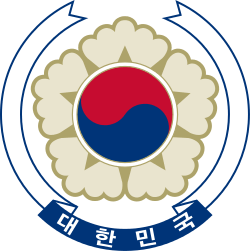Emblem of South Korea
| National Emblem of the Republic of Korea 대한민국의 국장 | |
|---|---|
 | |
| Details | |
| Armiger | Republic of Korea |
| Adopted | 1963 |
| Escutcheon | Taegeuk; Hibiscus syriacus |
 |
| Part of a series on the |
| Culture of Korea |
|---|
| History |
|
Music and performing arts |
|
|
Monuments |
|
National symbols of Korea |
|
The National Emblem of the Republic of Korea (Hangul: 대한민국의 국장 / Hanja: 大韓民國의 國章) consists of the taeguk symbol present on the country's national flag surrounded by five stylized petals and a ribbon bearing the inscription "The Republic of Korea" (Daehan Minguk), the official name of the country, in Hangul characters. The Taegeuk represents peace and harmony. The five petals all have meaning and are related to Korea's national flower, the Hibiscus syriacus, or Rose of Sharon (mugunghwa (무궁화/無窮花). The emblem was adopted in 1963.
-
.svg.png)
Emblem of South Korea - 1948-1963
-

Seal of the President of the Republic of Korea, with two phoenixes facing each other over a rose of Sharon.
-

Emblem of the National Government, a stylized Taeguk.
-

Emblem of the Prime Minister of the Republic of Korea. A rose of Sharon enclosed by another.
-

Emblem of the National Assembly of the Republic of Korea. The word "국회" meaning 'National Assembly' (gukhoe / 國會 in Hanja) appears in Hangeul in the center of a rose of Sharon.
See also
- Flag of South Korea
- Emblem of North Korea
- Imperial Seal of Korea, uses plum blossom instead
- Taegeuk
